#raziya sultan
Text
Razia Sultan
Raziyyat-Ud-Dunya Wa Ud-Din, popularly known as Razia Sultan, was born in 1205 and ruled the Delhi Sultanate from 1236 to 1240. She was the first and only female Muslim ruler of Delhi and the Indian subcontinent.
Razia's path to power was influenced by her father, Mamluk Sultan Shamsuddin Iltutmish. He recognized her capabilities and named her as his heir apparent after observing her administration of Delhi during his absence in 1231–1232. However, upon Iltutmish's death, her half-brother Ruknuddin Firuz seized the throne, backed by their mother Shah Turkan.
Razia, determined to claim her rightful position, incited a rebellion against her brother and his supporters. With the support of certain nobles and the public, she successfully overthrew Ruknuddin, ascending to the throne in 1236.
During her reign, Razia faced challenges from Turkic nobles who initially underestimated her but grew resentful of her assertive leadership. Despite opposition, she implemented policies that challenged traditional power structures, including appointing non-Turkic officers to key positions and leading military campaigns herself.
However, her rule was short-lived. In 1240, she was deposed by a group of nobles who opposed her policies. Razia attempted to regain power by marrying one of the rebels, Ikhtiyaruddin Altunia, but was ultimately defeated by her half-brother and successor, Muizuddin Bahram.
Razia Sultan's reign is significant for challenging gender norms in medieval Islamic societies. Her brief tenure as ruler symbolizes the potential for female empowerment in male-dominated political landscapes. Despite her ultimate defeat, Razia's legacy endures as a testament to her resilience and determination to defy societal expectations.
#razia sultan#sultan#raziya sultan#razia sultana#women in history#slave dynasty#indian royalty#indian women in history#history#indian history#delhi sultanate
6 notes
·
View notes
Text
#one world one smile#razia sultana#first woman ruler of india#biography of razia sultana#sultana razia: empress of india#first muslim woman ruler of india#raziya sultana#razia sultan biography in hindi#real history of razia sultan#indian history#razia sultan history#first turk woman ruler of a muslim sultanate#razia sultan 1st female ruler of delhi sultanate#south asia's first female monarch#the rise of razia sultana#first and last emperor of delhi sultanate#smile
0 notes
Text

An unprecedented female monarch in her dynasty, Rudrama Devi (r.1262-1289) presided over an age of prosperity. A successful warrior queen, she triumphed over both internal and external threats.
Her father’s heir
Rudrama Devi was the daughter of King Ganapati Deva (r.1199-1262) of the Kakatiya dynasty, who ruled over parts of present-day Telangana and Andhra Pradesh in Southern India. Their capital was located at Orugallu (Warangal).
Ganapati Deva was a successful monarch. His kingdom was famed for its’ diamonds and beautiful fabrics. He had no son to succeed him and his older daughter was already married. He thus decided to make his younger daughter Rudrama Devi his heir and gave her the requisite training.
A female monarch would nonetheless be a in vulnerable position and see her legitimacy questioned. To make female rule more acceptable, he arranged a Putrikayagna ceremony for his daughter. This religious rite allowed a sonless man to declare his daughter or his daughter’s son as his son. After that, Rudrama Devi was also known by the masculine name of Rudra Deva. She also attended all public meetings in masculine attire.
Her story is similar in that regard to that of her near-contemporary, Raziya Sultan of Delhi.
A warrior among warriors
In 1259, Rudrama Devi became her father’s co-ruler and assumed sole rule in 1262. She married the Chalukya prince Virabdhadra, who played no part in her administration, and with whom she had three daughters.
Rudrama Devi faced many threats at once. Her neighbors saw an opportunity to conquer her kingdom and her feudatory noblemen couldn’t stand being ruled by a woman.
She stood her ground and prevailed, proving her might as a warrior queen. Many of her nobles rebelled, but she successfully defeated them. The Seuna Yadava king, Mahadeva, invaded her territories and reached her capital. Rudrama Devi chased him after 15 days of fighting and forced them to pay a heavy tribute in money and horses.
To commemorate her victory, she styled herself “Rayagajakesari” or “the lion who rules over the elephant kings”. In the pavilion she built, she was depicted as a warrior mounted on a lion, holding a sword and a shield, with an elephant trunk holding up a lotus to her in sign of submission.
In 1262, another of her neighbors occupied the Vengi region. She was able to recover it after 12 years of fighting. She was nonetheless unsuccessful in fending off the attacks of her southern rival Ambadeva.
Meritocratic policies
Rudrama Devi completed the construction of the nearly impregnable Warangal Fort. She bought large tracts of land under cultivation, increasing her kingdom’s revenue. She also recruited non-aristocratic warriors from diverse castes. Only 17 percent of her subordinates were of noble background. Prominent commanders could receive lands and become feudatory nobles. She thus established a new warrior class. Since the nobility had rejected her rule, this meritocratic policy allowed her to surround herself with loyal retainers.
Marco Polo, who mistook her for a widow of the previous king, wrote about her very flattering terms, calling her a “lady of much discretion” and a “lover of justice, of equity and of peace”.
A warrior to the end
At the end of her reign, she chose her grandson, Prataparudra, as her heir.
Rudrama Devi likely died in 1289 (though some sources date her death from 1295) according to an inscription made by a member of her army commemorating her recent death and that of her army chief. The cause and location of her death are unknown. She likely died facing Ambadeva's armies, leading her troops as she had always done.
Further reading
Gupta Archana Garodia, The women who ruled India, leaders, warriors, icons
Janchariman M., Perspectives in Indian History From the Origins to AD 1857
Talbot Cynthia, "Rudrama‐devi, Queen of Kakatiya dynasty (r. 1262–1289)", In: The Oxford Encyclopedia of Women in World History.
Talbot Cynthia, Precolonial India in Practice: Society, Region, and Identity in Medieval Andhra
#rudrama devi#13th century#history#women in history#women's history#historyedit#women's history month#india#indian history#queens#powerful women#women warriors#warrior women#historical figures#herstory
77 notes
·
View notes
Photo

𝐀𝐁𝐎𝐔𝐓 𝐓𝐇𝐄 𝐁𝐎𝐎𝐊 : •• TITLE : The Book of Indian Queens •• AUTHOR : •• PUBLISHER : Aleph Books •• FORMAT : Hardcover •• LANGUAGE : English 𝐒𝐘𝐍𝐎𝐏𝐒𝐈𝐒 The book is a compilation of 11 stories which are based on different Indian queens. .. The compiled the stories of -> The Rani of Jhansi (Mahasweta Devi) -> The Room of Many Colours (Ruskin Bond) -> Rani Jindan Kaur (Chitra Banerjee Divakaruni) -> The Queens of Classical India (Abraham Eraly) -> The Controversial Queen of Kashmir (Archana Garodia Gupta) -> Raziya Bint Iltutmish, Slave to Sultan (Ira Mukhoty) -> Begum Hazrat Mahal ( Rudrangshu Mukherjee) -> Nur Jahan (Ruby Lal) -> The Maharanis of Travancore (Manu S. Pillai) -> Princess Sanatombi (Binodini) -> A princess Remembers (Gayatri Devi) .. To know more about the book find out it & give it a try. 𝐏𝐎𝐒𝐈𝐓𝐈𝐕𝐄𝐒 : ✓ The cover of the book is quite attractive in the dark black theme with golden fonts. ✓ The writing style of the book is quite good as it is a compilation of some of the greatest creations by legendary authors. ✓ Language used in the book is simple & easily connected. ✓ All the details about these historic personalities & their life is fully justified in this book. ✓ The Book has the historical background but it's never make you feel dragging or old school. This is the perfect replication of our glorious Indian culture. ✓ The book has its own beauty as it touches many aspects which are quite unpredictable. ✓ The author just perfectly maintained the main theme of the book along with its raw essence. ✓ Book is quite fast paced with so many detailing that you never going to pick it down once you start reading it. 𝐎𝐕𝐄𝐑𝐀𝐋𝐋 𝐒𝐓𝐀𝐑: 🌟🌟🌟🌟🌟 (at Bhubaneswar, India) https://www.instagram.com/p/CoFhSg9pakJ/?igshid=NGJjMDIxMWI=
0 notes
Photo

Painting of Sultan Raziya, first (and only) woman ruler of The Delhi Sultanate. The Mamluk Dynasty, specifically. She only ruled for three years, because of court being against her.
Time taken: Around 4-5 hours
I’ve decided that I like this painting style, but I need to work with it a lot more.
New signature! Think I like it.
#digital painting#women in history#sultan raziya#artists on tumblr#my art#blue's art#2020#Original Work
2 notes
·
View notes
Note
Hi. Indian here. Just wanted to clarify something that I find bothersome...About India being conservative and Patriarchal historically. It's true India is a primarily patriarchal society and has become opresive over the centuries. But before the many centuries of being colonized, plundered and ruled by non indegenous dynasties, the society was fairly progressive and encouraging of women's upliftment and education. The scholars Gargi, Apala, Maitreyi and Lopamudra were renowned women from the Vedic times. Even during the relatively later periods of theMughal and British raj, we had Queens like Raziya Sultan, Rani Lakshmibai, Ahilyabai Holker, Tarabai Bhonsle and Rani Chenamme who ruled kingdoms and led armies into war and are still remembered as able rulers.
I agree that 1800s were not free times, but these weren't free times for any Indians who didn't benefit the East India Company and later the Crown. Even men from prominent families faced hurdles in pursuing education or employment in British Administration above positions of clerks due to prejudice and racism. Women were obviously a lesser priority.
I am not giving excuses about the mistreatment of women in Indian society, it is still very much prevalent. But reducing our 5000 year old history to only 5-6 centuries is unfair to one of the oldest civilizations. Every civilization goes through a period of ruin after centuries of growth but we cannot deny its glory because of its downfall.
Just putting this out there....
Hi! Thank you for taking the time to write this!
I am aware about our rich cultural heritage before waves of invaders and colonizers fucked a lot of it up, and I know that the tides of liberalism and conservatism rise and fall with empires and time- as is the case with any culture in the world. And I'm fairly sure that the British did their fair share of imposing a sort of western conservatism that exists to this day in India, which probably did its part in preventing women from gaining employment (plus, where in the world at this time were women not facing employment discrimination?), as well as Indian men out of sheer racism.
Anyway, my point in an earlier post was not to compare British and Indian society in the 1800s because you just can't compare them without bias (and I will never do so). So when I discussed the role of young women in India and Britain, I was speaking more about the average woman who, unlike these female leaders and rulers you mentioned here (the Rani of Jhansi is a personal favorite- I've read the amar chitra katha on her A Lot), likely were raised to marry, have children, run a household, and not much else. But it was the same in both British and Indian cultures at the time, wasn't it? There were just little variances based on culture, class, religion, and caste.
Moral of the story is, I highly doubt Kate and Edwina Sharma were "free" in either India or London save maybe some stupid ton-specific rules and finnicky clothing requirements (high-waisted hoop skirts and ostrich feathers for court, anyone?) and being scrutinized much more in London (thanks Penelope).
6 notes
·
View notes
Text
I’ve been trying to wean off of overdosage of Napoleonic warfare and fandom, so I could go for a fresh start upon a new subject. I decided that I’d go for something related to my Muslim heritage and relevant to me as a woman, since I really love the idea of women soaring through the male dominated world. So here it is!!
Razia Sultan: The First and Last Woman Muslim Ruler of the Indian Subcontinent
Sultan Raziyyat-Ud-Dunya Wa Ud-Din, or also referred to as Razia Sultan was known as the first and last female Muslim Ruler of the Delhi Sultanate. She was born in 1205 into the household of Shams-us-din Iltutmish, a Mameluke Sultan, and a former slave under Qutb-ud-din, who had risen to the post of a provincial governor in Delhi. Turkan Khatun was her mother.
Razia was not like most women. Razia grew up under the influence of leading a man’s life out in the world, instead of being shut away into harems and living behind the purdah, the separation of women from men using rooms or curtains.
Unlike most Sultans, her father ensured great qualities in all his children, including Razia. Razia trained in archery, martial arts, and administration.
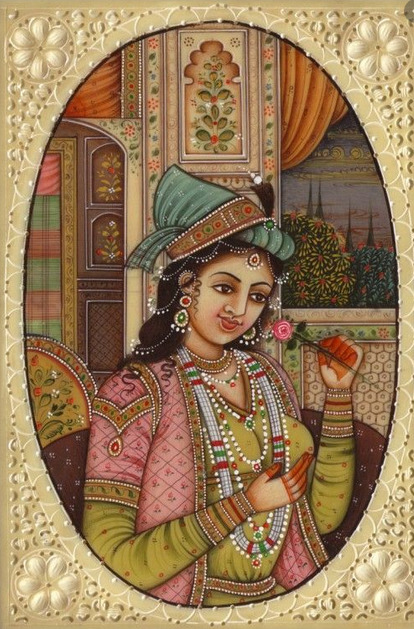
Ascension
Sultan Iltutmish had longed for his eldest Nasiruddin Mahmoud to be his successor, which unfortunately didn’t work out. He had died in 1229 mysteriously.
However, after Iltutmish's death, the nobles unanimously appointed his son Ruknuddin Firuz as his successor, who was Razia’s half-brother, and the son of Shah Turkan, Iltutmish’s lover. Proven to be an incapable and irrational ruler, this gave Razia a chance to prove herself. During a rebellion against Ruknuddin, Razia instigated the general public against Shah Turkan. He was deposed in 1236, six months after his rule. After the assassination of Ruknuddin and his mother, the throne was finally able to be taken by its rightful ruler.
Razia rose to the throne as Jalâlat ud-Dîn Raziyâ, after the assassination of her half-brother Ruknuddin and Iltutmish’s widow Shah Turkan after six months of his rule. Razia's ascension to the throne of Delhi was unique not only because she was a woman, but also because the support from the general public was the driving force behind her appointment.
Four Turkic nobles had joined with an army officer and decided to rebel against Razia’s ascension. As a result, she decided to seek help from the governor of Awadh, who was then captured by one Turkic nobles forced and killed in captivity. Razia then led an army out of the fortified city of Delhi to fight the rebels, and set up a camp on the banks of the Yamuna River. After a few skirmisher losses, tow of the rebel leaders joined Razia. They both had a discussion with her to capture the other rebel leaders. The other two Turkic nobles were arrested and executed. But the rebel officer escaped and hid in the Sirmaur Hills until his death.
Reign 1236-1240
She appeared in court without veil and in men’s attire. She had issued coins in her name.
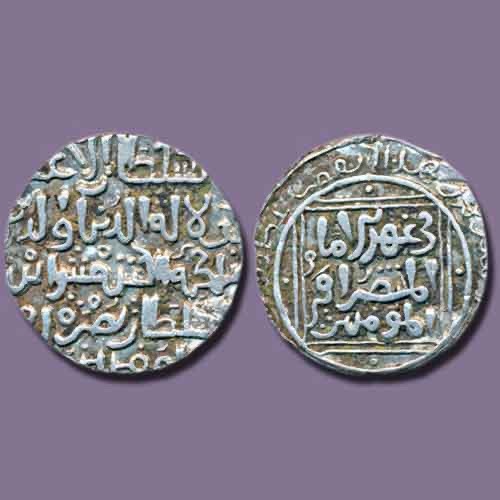

Throughout her reign, she faced lots of opposition from Turkic nobles in her court. Being aware of this, she appointed several non- Turkic nobles in high positions, which further created more opposition from her foes.
Razia appointed Malik Qutubuddin Hasan Ghuri to the newly created office of the army. Razia's first military campaign directed at non-rebels was an invasion of Ranthambore, whose Chahamana ruler had asserted his sovereignty after Iltutmish's death. Razia directed Ghuri to march to Ranthambore: he was able to evacuate the Turkic nobles and officers from the fort, but was unable to subjugate the Chahamanas. The Chahamanas, in alliance with the Mewatis, captured a large part of present-day north-eastern Rajasthan, and carried out guerilla war around Delhi. Razia also sent a force to re-assert Delhi's control over Gwalior, but this campaign had to be aborted.
The Shias had revolted against the Sultanate, but the rebellion was suppressed. One major incident occurred, when the Shia Qarmatians carried out an attack on the Jama masjid in Delhi. The Qarmatian leader Nuruddin Turk had earlier condemned the Sunni, Shafi‘i, and Hanafi doctrines, and had gathered nearly 1,000 supporters from Delhi, Gujarat, Sindh, and the Doab. On 5 March 1237, he and his supporters entered the mosque, and started killing the Sunnis assembled there for the Friday prayers, before being attacked by the citizens.
In 1238, Malik Hasan Qarlugh, the former Khwarazmian governor of Ghazni, faced a Mongol threat, and sent his son to Delhi, probably to seek a military alliance against the Mongols. Razia received the prince courteously, assigned him the revenues of Baran for his expenses, but refused to form an alliance against the Mongols.
Overthrow
The Turkic nobles wanted her to be a figurehead, but she asserted herself in her own power. By 1237–1238, she had started issuing coins solely in her own name. Razia appeared in front of her citizens in traditional male attire and rode elephants in the streets of Delhi like a typical Sultan.
In 1238–1239, Malik Izzuddin Kabir Khan Ayaz – the governor of Lahore – rebelled against Razia, and she marched against him, forcing him to flee to Sodhra. However, the area beyond Sodhra was controlled by the Mongols, yet Razia continued to pursue him. Izzuddin was forced to surrender and accept Razia's authority once again. Razia treated him leniently: she took away the iqta of Lahore from him, but assigned him the iqta of Multan, which Iltutmish had assigned to Ikhtiyaruddin Qaraqash Khan Aitigin.
Razia started showing favors to Ikhtiyaruddin Altunia, appointing him the iqta of Tabarhinda. However, him and another leader conspired to overthrow her, while she was away on her Lahore campaign. Once learning of this conspiracy, Razia marched towards Tabarhinda ten days later. The rebel forces imprisoned her.
Once news of her arrest reached Delhi, the Turkic nobles appointed Muizuddin Bahram, another son of Iltutmish. However, this Sultan was not the fairest. He had a former Ikhtiyaruddin Aitigin assassinated, who was supposed to handle affairs of the state. After hearing upon Razia’s return with her new husband, he led a rebel force against their’s. Altunia and Razia were forced to retreat to Kaithal.
Marriage and Relationships
She married, Ikhtiyaruddin Altunia in 1240, who was one of her enemies who sought to initially overthrow her in Tabarhinda. He and the rebel forces had her arrested.
The idea of the marriage came from the overthrow of Razia, after seeing disadvantages of the Delhi Sultanate, who failed to hold the kingdom together. Altunia lost all hope of realizing any benefits from Razia's overthrow, and decided to ally with Razia. Razia also saw this as an opportunity to win back the throne, and married Altunia in September 1240.
Razia also had a lover before her marriage, an Abyssinian slave named Yaqut.
She had no children in the marriage.
Death
Razia died in October 15, 1240 alongside her husband Altunia, after being deserted her soldiers, and from being assassinated by a group of Hindus.
Books
Jamila Brijbhushan, Sultan Raziya, Her Life and Times: A Reappraisal
Films and T.V. Shows
Kamal Amrohi’s Razia Sultana, 1983
Lead actress Hema Malini playing Razia Sultan.

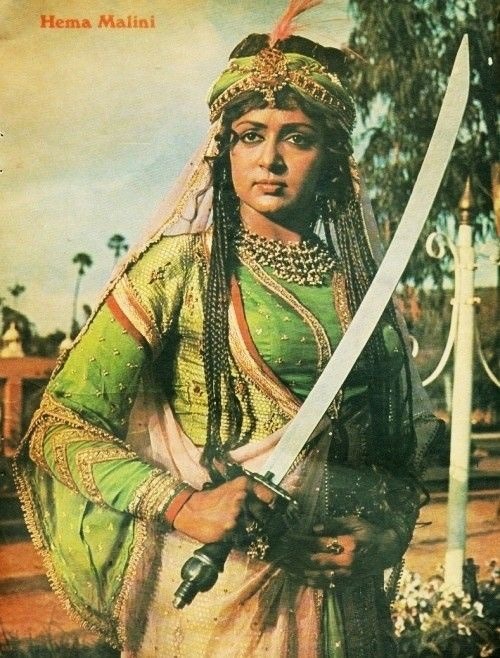
Zee T.V. Series, Razia Sultan, 2015
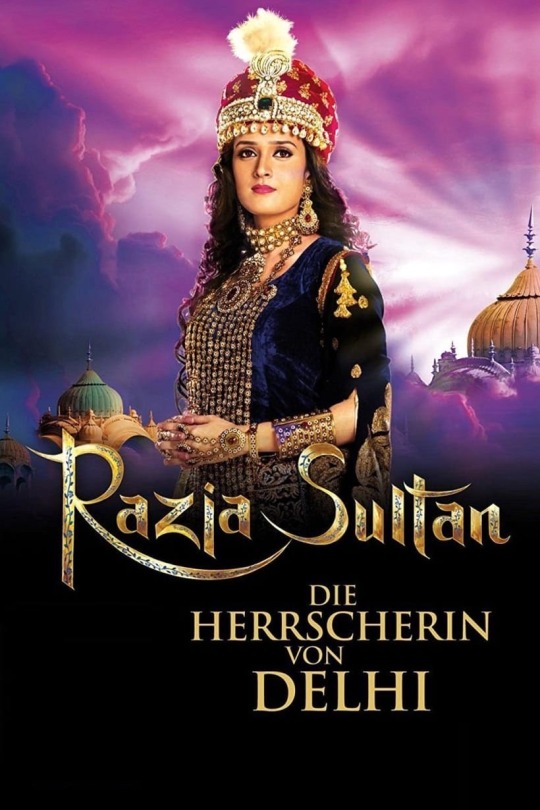
This poster is in German.
33 notes
·
View notes
Text
So I was looking through the history textbook of my third grade cousin, and this is what I saw-

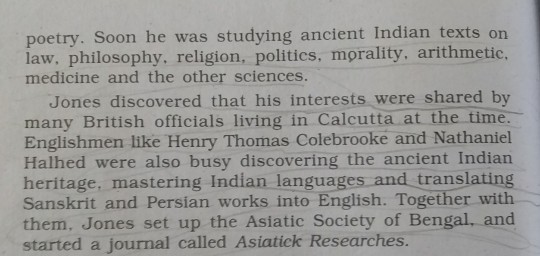
I don't know if you all see what's wrong in this one paragraph, but I see a lot of things.
1. A British person is trying to learn Sanskrit. Now I have nothing against British people learning Sanskrit, but I'm talking about this particular era, where colonisation was at its peak. Many British officers and scholars studied Sankrit to learn about India's past, since many ancient manuscripts were written in Sanskrit. That sounds like they were enlightening themselves on the pasts of the country they were ruling right? Inspiring?
No.
They did this to fool the kings and all higher power and learn trade secrets.
But this is not what greatly disturbed me. What disturbed me was that we were learning the name of a man who's country slaved us for 200 years, stripped us of power and money and everything that could have made India a first world country instead of a third world country. They were teaching us the names of the British scholars but not in one sentence did I find the names of the "Pandits" that taught him sankrit.
Indian kids are rarely taught about the Indian culture or the people involved there. I learnt about Aryabhatta through MATHS not history! I learnt about Akbar and Raziya Sultan and Chanakya through TV shows and children's books.
And parents ask us why do we know about British and American and French history more than we do our own Indian history, when the education system that's supposedly so important for life to go on failed us.
34 notes
·
View notes
Photo

Youm e Wisaal / Urs e Mubarak Hazrat Makhdoom Sharf-ud-deen Ahmad bin Yahyā Maneri rahmatullāhi alaihi Alqaab :Makhdoom-ul Mulk, Makhdoom-e-Jahaan,Sultan-ul-Muhaqqeen. Aap ki wilaadat 29 Sha’abaan 661 Hijri (July 1263 A.D.) ko Maner (Patna, Bihar) me hui. Aap ke waalid ka naam Hazrat Makhdoom Kamaal-ud-deen Yahyā Maneri bin Makhdoom Israeel rahmatullāhi alaihi aur waalida ka naam Bubu Raziya binte Makhdoom Sayyed Shahaab-ud-deen Peer Jagjot Balkhi hai. Aap ke pardaada Maulana Muhammad Taaj-ud-deen (Jerusalem ke qareeb) Quds al-Khalil se Hind me aaye the aur Maner me muqeem hue the. Bachpan se hi Aap ko husool e ilm me dilchaspi thi.12 saal me umr me Narayanganj ke qareeb Sonargaon jaakar Hazrat Ashraf-ud-deen Abu Towama Bukhari se Arabi, Faarsi, Falsafa, Ilme Istedalaal ki ta’aleem haasil ki. Aap 24 saal tak Hazrat ki khidmat me rahe.Is ke baad Aap Delhi tashreef le gaye. Waha Aap ne Hazrat Khwaja Nizaam-ud-deen Auliya rahmatullāhi alaihi aur deegar asfiya se faiz haasil kiya. Aakhirkaar Aap apne bade bhai Makhdoom Jaleel-ud-deen Maneri rahmatullāhi alaihi ke saath Mehrauli me Hazrat Shaikh Najeeb-ud-deen Firdausi rahmatullāhi alaihi ki baargaah me aaye aur Hazrat ke mureed hue. Phir Aap Maner ke qareeb Bihiya ke jangal me aur phir Rajgir me mujaahida karte rahe. 30 saal tak mujaahida karne ke baad Aap Bihar Sharif me sukoonat pazeer hue. Aap Hazrat Shaikh Najeeb-ud-deen Firdausi rahmatullāhi alaihi ke mureed aur khalifa hain.Aur ‘(Suharwardi Kubrawiya) Firdausi’ silsila ke Shaikh hain. Aap ke khulfa : (1) Qaazi Shams-ud-deen rahmatullāhi alaihi,(2) Maulana Muzaffar Shams Balkhi rahmatullāhi alaihi,(3) Shaikh Rukn-ud-deen rahmatullāhi alaihi,(4) Shaikh Zain-ul-Badr Arabi rahmatullāhi alaihi. Aap ka wisaal 6 Shawwaal 782 Hijri (January 1381 A.D.) ko Jumeraat ke roz hua.Aap ka mazaar Badi Dargaah, Bihar Sharif (Bihar) me hai. #faizaan_e_auliya @faizaan_e_auliya #dargah #biharsharif #uttarpradesh #bihar #patna #westbengal #kolkatta #naqshbandihaqqani #sunni #tomb #lahore #dehli #khwaja #pirsaqibshaami #pakistan #sufi #sufism #sufisaint #kgn #khwaja #nizamuddindargah #ahlebait #islam #ajmer #ahlesunnat #dawateislami #alahazrat #aulia #muslim #alhamdulillah (at Dargah Makhdoom Sharfuddin Yahya Maneri Bihar Sharif) https://www.instagram.com/p/CPGH_mQh670/?utm_medium=tumblr
#faizaan_e_auliya#dargah#biharsharif#uttarpradesh#bihar#patna#westbengal#kolkatta#naqshbandihaqqani#sunni#tomb#lahore#dehli#khwaja#pirsaqibshaami#pakistan#sufi#sufism#sufisaint#kgn#nizamuddindargah#ahlebait#islam#ajmer#ahlesunnat#dawateislami#alahazrat#aulia#muslim#alhamdulillah
4 notes
·
View notes
Text
Raziya Was India’s First Female Muslim Ruler and A Brave Warrior
Raziya Was India’s First Female Muslim Ruler and A Brave Warrior

Given the fact that Shams-Al-Din Iltutmish entered the court of the Delhi sultanate as a Turk slave and died as Sultan of Delhi, might have been the first indication that his daughter, Jalalat-Al-Din Raziya was destined for greatness. In 1236, Jalalat-Al-Din Raziya, historically referred to as Razia Sultan, ascended the throne as the first female ruler of the Delhi Sultanate. Though, her story might be perceived as romantic in popular culture, reality was anything but romantic.
The First Female Successor for the Throne
Iltutmish arrived at the Delhi sultanate as a Turk slave. He grew to be a great favorite of his master, Qutb Al-Din Aibak, the first Sultan of Delhi and so was married to the sultan’s daughter Qutub Begum becoming an actual part of the ruling family. With Qutb-Al-Din Aibak, he had a son Nasiruddin Mahmud and a daughter Jalalat-Al-Din Raziya. When Raziya was still a child, her grandfather Aibak died and her father became second Sultan of Delhi.
During the final years of his life, Sultan Iltutmish had to make an important decision. Whom would he hand-over the administration of the sultanate? Based on qabliyat (i.e. capability), Iltutmish would have chosen his son Nasiruddin Mahmud, who at that time also ruled as governor of Bengal. Yet, under mysterious circumstance, Nasiruddin Mahmud died and Iltutmish was at a loss. None of his other sons, born from his other wives, were too young to be crowned his successor.
His daughter Raziya had already shown her capability of managing the sultanate. When her father left for business or campaigning affairs, she took charges as a competent regent with the assistance of the Sultan’s trusted minister. She had become a well-educated woman, both in formal education as in the Qu’ran. Moreover, she was skilled in martial arts and, thus, an excellent trained warrior, rode both horses and elephants with an exquisite accomplishment and exercised authority with great dignity.
Without consulting the ulama (i.e. scholars within the Muslim law), Iltutmish appointed his daughter Jalalat-Al-Din Raziya as his successor, for he saw “the signs of power and bravery” in her. Whenever someone questioned his decision he would reply: “My sons are devoted to the pleasures of the youth, and not one of them is qualified to be king […]. After my death, you will find that there is none more competent to guide the state than my daughter.” As such, Iltutmish became the first Sultan to appoint a woman as his heir apparent.

A Devoted Leader of her Empire and Subjects
She established schools, academics, research centers and public libraries where both Islamic tradition manuscripts and Hindu works shared places.
As a woman, Raziya was not given full support from the noblemen. She only managed to secure her control over the throne by dividing the opposition. After her official accession, many nobles opposed her. Ultimately, she won the majority over and the kingdom slumbered into peace again. She could extend the power of the state widely through the obedience and submission of maliks (i.e. kings) and amirs (i.e. state leaders).
By building a system of roads, she could easily inform herself of the affairs in the distant parts of the empire. She linked towns up with villages and built small forts as guard posts around these routes. In addition, she established schools, academics, research centers and public libraries where both Islamic tradition manuscripts and Hindu works shared places. Only one of the many examples that showed that Raziya considered the Muslim community and the Hindu community on an equal footing.
Raziya was clearly a devoted leader for her empire and subjects. She listened to her people’s complaints and demands, trying to reserve herself as a guiding hand among them instead of an indifferent ruler. By stating her title to be officially Raziya Sultan, rather than Raziya Sultana, she underlined her rightful credibility as a powerful sovereign leader of the Sultanate of Delhi. As her desire was to keep close relations with her people, Raziya Sultan substituted her female attire with that of a man’s head-dress and tunic, abandoned the veil and rode out on elephant without purdah (i.e. covering of the face).
A Conspiracy That Secured the Existing Opposition of Raziya’s Noblemen
Letting Raziya assume power, her noblemen had expected their female ruler to be a puppet in their hands. Instead, Raziya openly confessed herself to be an independent leader which caused much dissatisfaction among her nobles. With the arrival of Jamaluddin Yakut, a Habshi (i.e. Ethiopian) slave, the last straw was drawn.
Yakut had a calm and dependable nature, something that lead to Raziya favouring him so much to elevate him to position of Amir-i-Akhur (i.e. intendent of the royal stables). This position was a strategic position, very close to the sovereign. Raziya Sultan had basically made a non-Turk commander of her army. She did not intend to counter the power of her Turkish nobles whom, at that moment had monopolized that position, but her choice eventually led to their decision to dispose her. Together, Malik-i-Kabir Ikthiyaruddin Aitigin and Ghiyasussin Balban, set a conspiracy into motion against Raziya Sultan and a key chess piece in their plan was Malik Ikhtiyauddin Mirza Altunia.
Malik Ikhtiyauddin Mirza Altunia, a prominent noble man under Raziya’s father reign, had supported Raziya’s accession. Raziya favored him and had him rewarded with governorship of Tabarhinda (Bhatinda). Before his departure to Tabarhinda, he offered marriage to Raziya which she refused stating that her priority was taking care of the empire. Aitigin and Balban took advantage of Altunia’s absence and told him rumors about Raziya’s and Yakut’s intimacy. The fact that Raziya and Yakut were always together, discussing affairs concerning the empire and she asking him advice about strategies, Aitign and Balban could arouse Altunia’s jealousy by telling them that Raziya was in love with Yakut. In anger, Altunia joined the opposition of the rebels, offered his help to depose the Sultan and by doing so, he would receive a portion of the empire.
A Prisoner Who Wins Over Her Captor to Win Back her Throne
The noblemen could not oppose Raziya in Delhi, as she had joined most her subjects in support for her rule, therefore rebellions were started in the distant provinces. One of the many rebellions came from Tabarhinda, Altunia’s government, a place she never expected rebellion to be stirred. Still, she asked Yakut to prepare the march against Altunia. At that moment, the army was exhausted, having put down a different rebellion in Lahore and Yakut was afraid that victory would come so easily this time. Due to his loyalty, he did not discourage the Sultan.
During the battle, Altunia realized that to defeat Raziya and to gain power for the nobles at Dehli, he had to kill Yakut. With the death of the commander of the army, soldiers lost their confidence and eventually surrendered to Altunia. Still trying to inspire her forces, Raziya sultan failed and was taking prisoner.
Meanwhile, the noblemen at Delhi assigned a new sultan, Raziya’s stepbrother Muizuddin Bahram Shah. He was a drunkard and finally could serve as the puppet the noblemen wanted. During his reign, the people were oppressed and opponents of the empire were unmercifully killed. Th promise that the noblemen had made to Altunia was forgotten. Raziya, still captured, realized that in order to restore her throne, she had to convince Altunia of fighting against a common enemy. Alluring him with the promise of power and rule in the sultanate, Altunia decided to help her. After their marriage, Altunia and Raziya recruited an army to win back Delhi.
A Story Made Romantic
It is not known who made the offer of marriage first. In any case, it did not last very long. Nearing Delhi, Bahram Shah knew that the only way he could win was killing Raziya. The people of Delhi were still allied to Raziya Sultan and merely her presence was enough to harden their love and respect for her. Unfortunately, Raziya Sultan was defeated.
Not much is known about the cause of her death. Some believe she fought as a valiant warrior on the battlefield until an arrow struck her. Others say she was defeated and fled where her survival was depending on a man who gave her bread and a place to sleep. During her sleep, the man saw a tunic of gold and pearls under her male army garment and realized that the man he had helped was a woman. He killed her, buried her body and took her valuables to sell on the market.
Popular culture turns Raziya’s life into a romantic story. The supposed love triangle has been source for various on-screen adaptations: Raziya having an affair with her noblemen but growing overly dependent on the Abyssinian slave, leading to a jealous lover and her subsequent defeat. How many inaccurate versions may exist, we should never forget Raziya Sultan’s true story: that of an independent female ruler who fought until the bitter end for her Empire!
Sources
Brijbhushan Jamila: Sultan Raziya: Her Life and Times: A Reappraisal (Manohar Publications, New Delhi : 1990) – Chandra Satish: Medieval India: From Sultanat to the Mughals : Delhi Sultanat [1206-1526] (Har- Anand Publications Pvt. Ltd., New Delhi :1997, rpt. 2015) – Dasgupta Shahana: Razia: The People’s Queen (Rupa & Co., New Delhi : 2001) – Eraly Abraham: The Age of Wrath: A History of the Delhi Sultanate (Penguin Books, India : 2014) – Fatima Mernissi, The Forgotten Queens of Islam (Polity Press 1993, 1993)
https://ift.tt/2KXiIGT . Foreign Articles November 26, 2019 at 08:17PM
4 notes
·
View notes
Photo

Grave of Razia Sultan in Bulbul-i-Khan near Turkoman Gate, Delhi
Sultana Raziya (Persian: سُلْطَنَاه رَضِيَه), attributed as Raziya Sultana, or popularly known as Razia Sultan (Persian: رَضِيَه سُلْطَان) (circa. 1205 – 14 October 1240), (known in Arabic: رَضِيَة بِنْت إِلْتُتْمِش, translit. Radhiyah bint Iltutmish) was the Sultanah of Delhi from 10 October 1236 to 14 October 1240. A member of the Mamluk dynasty, she is known for being the only female ever to rule the Delhi Sultanate and the only female ruler of Delhi.
#Razia Sultana#Indian History#Delhi Sultanate#Sultana#Mamluk Dynasty#Mamluk Era#tomb#Bulbul-i-Khan#Delhi#Turkoman Gate#photo#photography
4 notes
·
View notes
Photo
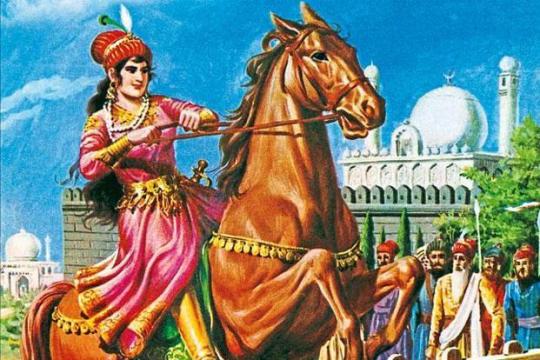
Raziya Sultan - First female ruler of the Delhi Sultanate
Raziya Sultan (around 1205-1240) was the first and only woman to rule over the Delhi Sultanate in India. Though her reign was short, she’s regarded as one of the most able of the Delhi sultans. The most complete contemporary account of her reign was written 21 years after her death by one of her opponents, but remains mostly unbiased.
Raziya’s father, Shams-ud-Din Iltutmish was a Turk slave brought to India from the Central Asian steppes. As a soldier, he served Muhammad Gori, the founder the first lasting Turkish sultanate in South Asia. Iltutmish was freed in 1206. After the dead of Muhammad Gori, he led a faction of the nobles and deposed Gori’s son, seizing power for himself in 1211 and moving the capital from Lahore to Delhi.
Raizya received the same education as her brothers. She was allowed to attend court and was taught military skills and statecraft. The fact that Iltutmish came from the steppes of Central Asia may have influenced his views. Women from nomadic pastoral societies played an important role and even took part in warfare, since every member of the tribe had to be useful. Raziya thus held important posts in his government, dealing notably with financial matters. Finding her more skilled than her two half-brothers, Iltutmish named her heir apparent.
Such a decision was unprecedented and was met with opposition. When Iltutmish died in 1236, his son Rukn-ud-Din was proclaimed sultan. Provincial governors soon rebelled. While Rukn-ud-Din’s army marched to meet them, Raziya won the support of Delhi’s Muslim population. She took control of the palace and was proclaimed sultan. When Rukn-ud-Din came back, he was executed.
Raziya wore a male garb. She appeared in public unveiled, her hair cut short, with a sword, a bow and a quiver at her side. One of her first actions was to strike coins with the following inscriptions:
“Pillar of Women/ Queen of the Eras/ Sultana Raziya Bint Shams al-Din Iltutmish (Sultana Raziya the daughter of Shams al-Din Iltumish)” and “In the Era of Imam al-Mustansir / Commander of the Faithful, Mighty Sultan / Splendour of the World and the Faith/ Malika Iltutmish, Daughter of Sultan Iltutmish /She who Brings Glory to the Commander of the Faithful”.

One of her first challenges was to deal with the rebel governors of the western provinces. Though she had few military forces at her disposal, she was a skilled commander. Her tactics were bold and she led her army from the front during battles. She also used propaganda, threats and bribes and managed to crush the rebellion.
As a ruler, she was competent and fair and notably established several educational institutions and public libraries. Her power was still threatened and conspiracies led her to become more and more authoritarian, notably sentencing the governor of Gwalior to death. Rumors spread that she had an affair with a slave and traditionalists opposed the rule of a woman. Local governors started to show their defiance. When a revolt arose in Bathinda, she led her army to crush it, but was defeated and captured. One of her half-brothers was named sultan in her place.
Raziya’s captor, Altuniah, seeing himself rejected from the political maneuvers, decided to ally himself with her. The two married and agreed to share the power. Raziya rode toward Delhi at the head of her army, but her troops were dispirited. She was once again defeated. In one account, she and Altuniah were captured and beheaded. In another, she escaped, but was killed by a farmer who wanted to steal her valuables.
Even though she reined only 4 years, Raziya is still regarded as one of the most capable Delhi sultans. Minhaj-us-Siraj wrote in 1261 that:
“Sultan Raziya was a great monarch. She was wise, just, and generous, a benefactor to her kingdom, a dispenser of justice, the protector of her subjects and the leader of her armies. She was endowed with all the qualities befitting a king, but she was not born of the right sex, and so in the estimation of men, all these virtues were useless”.
References:
Ali Adam, “Sultana Raziya of Delhi: Pillar of women and queen of the eras”
Hoover James W., “Raziya, Sultan”, in: Higham Robin, Pennington Reina (ed.), Amazons to fighter pilots, biographical dictionary of military women, vol.2
Priyamvada Pooja, “Razia Sultan: The first and last woman ruler of Delhi Sultanate”
#13th century#india#indian history#Raziya sultan#razia sultan#warrior women#warrior queen#women warriors#badass women#women in history#female soldiers#female rulers#queens#muslim women#women in war#Delhi sultanate#military history#women's history month#women's history
169 notes
·
View notes
Photo
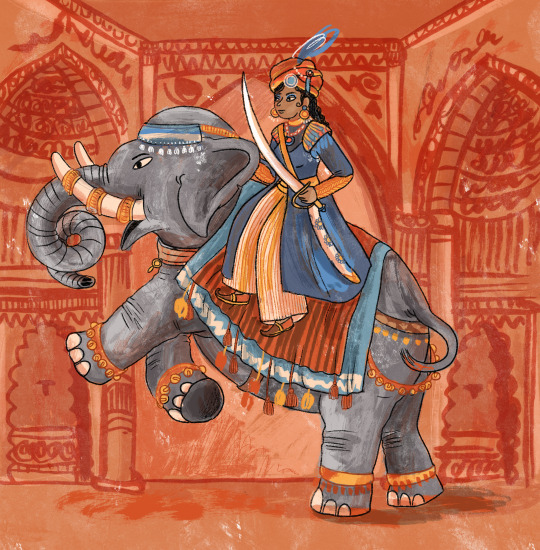
Raziya al-Din, born in 1205, (ruled 1236–1240), popularly known as Razia Sultana, was a ruler of the Delhi Sultanate in the northern part of the Indian subcontinent. She is notable for being the first female Muslim ruler of the Indian Subcontinent.
https://en.wikipedia.org/wiki/Razia_Sultana
Illustrated by Noa Kelner
0 notes
Photo

Brand Apana Cotton Catalog RAZIA SULTAN VOL 21 Pcs 10 AVG. Price 299 Full Price 2990 Full Price With Gst 3139.5 Size Unstitched, Fabric COTTON Initial Delivery January 18, 2020 Availability On Booking Other Details APANA COTTON RAZIYA-SULTAN VOL-21 ✅Quality Fabrics…. No.1 ✅Best Designs…. ✅Latest Colours…. ✅Rich Combinations…. @ unbelievable price, Fabric Details:- Top :- Pure Cotton . cut:-2.50 MTR approx Bot :- Pure cotton dyed cut:-2.00 MTR approx Dup : Pure cotton 2.25 MTR approx https://www.instagram.com/p/B7WcfjaB0kN/?igshid=1ik5jru6ys7vc
0 notes
Photo

RAZIA SULTAN VOL 19 BY APANA COTTON PAKISTANI PRINTED SUITS ONLINE has been published on https://nekfabrics.com/portfolio/razia-sultan-vol-19-by-apana-cotton-pakistani-printed-suits-online/
RAZIA SULTAN VOL 19 BY APANA COTTON PAKISTANI PRINTED SUITS ONLINE
BOOK CATALOGUE RAZIA SULTAN VOL 19 ON NEK FABRICS .CALL ON +91-8094146999
AVAILABILITY: ON BOOKING RAZIA SULTAN VOL 19
Apana Cotton Presents Latest Collection Salwar Kameez Launched on . Presenting Beautiful collection of 10 PCS with Unstitched .
RAZIA SULTAN VOL 19 BY APANA COTTON PAKISTANI PRINTED SUITS ONLINE
#gallery-18 margin: auto; #gallery-18 .gallery-item float: left; margin-top: 10px; text-align: center; width: 50%; #gallery-18 img border: 2px solid #cfcfcf; #gallery-18 .gallery-caption margin-left: 0; /* see gallery_shortcode() in wp-includes/media.php */
RAZIA SULTAN VOL 19 BY APANA COTTON PAKISTANI PRINTED SUITS ONLINE
Brand Apana Cotton Catalog RAZIA SULTAN VOL 19 Pcs 10 AVG. Price 299 Full Price 2990 Size Unstitched Fabric COTTON Initial Delivery Availability On Booking Other Details We are launching New catalogue with different elegant designer print suit. RAZIYA-SULTAN VOL-19 ✅Quality Fabrics…. No.1
✅Best Designs….
✅Latest Colours….
✅Rich Combinations….
@ unbelievable priceFabric Details:- Top :- Pure Cotton . cut:-2.50 MTR approx Bot :- Pure cotton dyed cut:-2.00 MTR approx Dup : Pure cotton 2.25 MTR approx* Price details whatsapp my number Designs: 10Rate ~ 299/-₹ Note Stitching available on customer Requirment For Sarees , Salwar Kameez, Lehengha.(i.e M,L,XL,XXL).
ABOUT NEK FABRICS
NEK FABRICS- Exporter and Supplier of Designer Sarees, Printed Sarees, Fancy Sarees, Embroidery Sarees, Half and Half Sarees, Lace work Sarees, Designer Salwar Suit, Fancy Anarkali Suit, Designer Suits, Casual wear Kurtis, Party Wear Kurtis, Digital Printed Kurtis, Dupatta, Scarf, Stoles, Abaya, Hijaab, Lehngas, Designer Lehnga, Bridal Lehnga, Surat, Gujarat, India.
FOR WHOLESALE UPDATES +91-9909999589
BANK DETAIL
Bank HDFC BANK Ac.Name Ac. No. Type IFSC Code Branch CITY LIGHT, SURAT Note Goods Will be dispatched only after
Payment is recived in our bank account.
Call or Whatsapp on +91-8094146999
0 notes
Text
SULTAN JALALAT-UD-DIN RAZIYA-A MONARCH IN HER OWN RIGHT.

She took over the throne as SULTAN JALALAT-UD-DIN RAZIYA in 1236. She refused to be addressed as Sultana referring to her gender, for she believed sultana meant wife or mistress and she was none. Rather, she was the successor nominated by her father, who proudly said that she was equal to 20 of his sons. She was much more able and qualified than any of her brothers. It was a matter of ability,…
View On WordPress
#blog#blogger#bravery#gender-neutral#history#inspiration#islam#life#monarch#motivation#Philosophy#razia-sultan#religion#sacrifice
0 notes